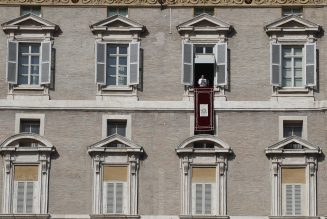If you have never wept for joy at, or been shaken to the roots of your being by, music, here is the music to do it. Should I ever have the privilege of hearing God’s orchestra play, I am not sure what I will hear. But if it is Sibelius’s Fifth Symphony, I will know where I am.
 The reputation of Finnish composer Jean Sibelius (1865-1957) has waxed and waned over the course of this century. In the early part, he was thought by many to be the second most powerful symphonist next to Beethoven, and was certainly the most often performed contemporary composer of that time. In his famous book of 1934, Music Ho!, English composer Constant Lambert predicted that Sibelius’s was the music of the future, leading the way out of an exhausted tradition while avoiding the sterility of Arnold Schoenberg’s dodecaphony. In the aftermath of World War II, however, his reputation began to plummet. He was denounced vitriolically by influential critics like Virgil Thompson and the Marxist twelve-tone disciple Theodor Adorno. Sibelius saw his eclipse coming, and said, “For a time, maybe, little notice will be taken of my works, but I believe that I can hope that they will not be completely forgotten. In every true work of art there is a spark that can never entirely be extinguished.”
The reputation of Finnish composer Jean Sibelius (1865-1957) has waxed and waned over the course of this century. In the early part, he was thought by many to be the second most powerful symphonist next to Beethoven, and was certainly the most often performed contemporary composer of that time. In his famous book of 1934, Music Ho!, English composer Constant Lambert predicted that Sibelius’s was the music of the future, leading the way out of an exhausted tradition while avoiding the sterility of Arnold Schoenberg’s dodecaphony. In the aftermath of World War II, however, his reputation began to plummet. He was denounced vitriolically by influential critics like Virgil Thompson and the Marxist twelve-tone disciple Theodor Adorno. Sibelius saw his eclipse coming, and said, “For a time, maybe, little notice will be taken of my works, but I believe that I can hope that they will not be completely forgotten. In every true work of art there is a spark that can never entirely be extinguished.”
Sibelius was right. This last December saw a major Sibelius revival at New York’s Lincoln Center, with Sir Colin Davis leading the London Symphony Orchestra in several concerts. Davis had just completed his second recorded traversal of the complete Sibelius symphonies. Twenty years ago, he recorded them for the first time with the Boston Symphony Orchestra for Philips. His new cycle with the London forces is on RCA Victor (BMG). Both are magnificent achievements that prove the durability of Sibelius’s spark. Thanks to recordings such as these, as well as those by Thomas Beecham, Leonard Bernstein, Paavo Berglund, Vladimir Ashkenazy, Herbert von Karajan and others, Sibelius never really completely receded from view. Although his music may have been absent from concert halls, the popularity of Sibelius recordings shows that audiences loved his music no matter how often critics told them not to.
As Davis’s recordings attest, there is more than a spark in Sibelius; there is a conflagration of inspiration. His seven symphonies and many tone poems contain some of the most sublime and visionary utterances in all music. His compositions are perhaps best understood in contrast to those of his great contemporary in Denmark, Carl Nielsen. Sibelius’s music is a revelation of nature in all of its solitary majesty and portentiousness. Man is the spectator of the awesome drama that is unfolded before him and before which he must tremble, even in his exhilaration. In Nielsen’s music, on the other hand, man is very much a participant in the cosmic drama, and the revelation is one of the human spirit in contention against, and at times triumphant over, terrible and malignant forces that seek to extinguish that spirit.
Apart from the Finnish mythological figures of the Kalevala with whom Sibelius deals in his tone poems, there are no people in his music. This not so much limits Sibelius’s music as defines it. Imagine one of the breathtaking nature portraits from the Hudson River Valley School of painting that depicts a stupendous mountain range. It matters very much if there are tiny human figures in the foreground of the painting. Such figures may provide a sense of scale, but an audience inside the painting also changes the relationship of what is depicted to the audience outside. They are distracted from the main event. With Sibelius, there are no people interposing themselves between what he portrays and you, the listener. There is nothing there to distract from the solitary grandeur and mystery of nature. Its impact is direct and overwhelming.
Because he composed such stirring tonal music with nature as its subject, Sibelius has often, and I believe mistakenly, been labeled a Romantic. He is certainly not one in the conventional sense. The late Glenn Gould described Sibelius’s music as “passionate but anti-sensuous.” Sibelius is uninterested in letting us know how he feels about the mountain. He wants to show the mountain itself. His music is not autobiographical. The sensibility behind, for example, Richard Strauss’s Ein Heldenleben (A Hero’s Life) is completely foreign to him. So is Mahler’s self-indulgence. If anything, Sibelius’s music was, in part, a reaction against this kind of late Romanticism. Sibelius’s attitude toward nature is worth exploring because it may have something to do with the ups and downs of his reputation.
Sibelius said, “There is music in the whole universe.” He believed in the “Music of the Spheres,” the classical Greek view that held that the mathematical relationships among the heavenly bodies are the same as those of music. The heavens are literally harmonious. He said, “I believe that there are musical notes and harmonies on all planets.” This included planet earth. Sibelius’s experience of the world was essentially musical. He was one of those extraordinary individuals gifted with perfect pitch. He not only noted the key and character in which various birds sang, but experienced the most commonplace, everyday sounds in musical terms. Once, when a repairman was hammering away on the veranda, Sibelius observed, “The man is all the time hitting a g that is about a quarter-tone out of tune.” Sibelius also experienced colors musically, and often whole visual scenes resolved themselves into musical forms for him. As a young boy, he sat at the piano and tried to play the colors he saw in the parlor carpet. His favorite, a clear green, he said, was “somewhere between d and e flat.” When he first heard the sounds of orchestral instruments, they seemed at once familiar to him. Sibelius never wrote in short score. He heard his music orchestrally; each sound came to him instrumentally—as it were, without intermediaries.
Sibelius saw the larger significance of the musical harmony of the world, and it is the key to the meaning and power of his music. One day, Sibelius spoke to his personal secretary Santeri Levas about the astonishing sense of law in the universe, and an almost inconceivable harmony that makes every human effort seem tiny and senseless. This realization did not induce in him a sense of futility, but of humility. “That,” Sibelius concluded, “is what I call God.”
Though Sibelius was not religious in a conventional sense, he was a deep believer. “The essence of man’s being,” he said, “is his striving after God.” He saw art as hieratic and composition as a vocation. In words that could hardly go more directly to the heart of the matter, he said, “It [composition] is brought to life by means of the Logos, the divine in art. That is the only thing that really has significance.”
Sibelius tried to make the transcendent perceptible in music. In his diary of 1915, he wrote of his struggle in composing the Fifth Symphony. He said that it was “as if God the Father had thrown down pieces of mosaic out of the heaven’s floor and asked me to solve how the picture once looked.” He later noted, “I begin to see the mountain that I shall surely ascend. God opens His door for a moment and His orchestra plays the Fifth Symphony.” While that may seem an immodest remark for a composer to make about his own work, it nonetheless makes clear the goal for which he was reaching. He reflected, “I have always found that the Almighty reveals Himself to me most clearly through my musical understanding, in that wonderful artistic logic that I seldom notice as I compose but can recognize afterward—when the composition is finished.” The listener also recognizes that a revelation has taken place and is left in awe of that mysterious communication. In the Fifth Symphony, for example, the feeling of an elemental force overtaking and uplifting one is overpowering. As in many parts of the other symphonies, there are moments in the Fifth when the music no longer sounds as if it is being made by instruments. It comes from another world. Sibelius’s music reflects nature in such a way that it becomes an invitation to natural theology.
Modernity, of course, has militated against Sibelius’s sensibility. In a recent Harpers article, novelist Annie Dillard, clearly upset at the size of the universe, expressed the deflationary modern view: “We arise from dirt and dwindle to dirt, and the might of the universe is arrayed against us.” Some years before her, Sibelius’s fellow Scandinavian Ingmar Bergman summed up this view of life by saying: “You were born without purpose, you live without meaning…. When you die, you are extinguished.” There is music of sorts that goes with this worldview: the music of much of the 20th century. Of it, Sibelius exclaimed, “It is inconceivable that ethics are entirely missing in what is written now.” He called the results “sound effects” devoid of any inner life. One finds in such music that futility does not lead to humility. Rather, awe is replaced with anguish, anger, and the sound of gnarling. Today, this view has pretty much exhausted itself in artistic terms. How much uglier could art become?
As a result, the curse has been lifted from Sibelius. A January 9th Washington Post review of a National Symphony Orchestra concert gives further proof of this contention. Pulitzer Prize–winning critic Tim Page lambasted the Washington premiere of Wolfgang Rihm’s In-Schrift as “just one more example of disjunct, angst-ridden, ‘Death-of-the-Universe’ avant-garde aggression,” while he found Sibelius, “written off as an anachronism for several misguided decades… astonishingly fresh and full of mystery, even in a work [the Violin Concerto] that is almost 100 years old.”
It even appears that Constant Lambert’s prediction, long ago dismissed as ridiculous, may have some merit to it. Sibelius was so individual a genius that he left no school behind him. But many more composers than initially suspected have been deeply influenced by him. In the United States, their number includes Roy Harris, Walter Piston, Howard Hanson, and more recently John Adams and Steve Albert. In Scandinavia and the Baltic region, Aulis Sallinen, Einojuhani Rautavaara, and Peteris Vasks, to name a few, all learned valuable lessons from Sibelius. The great English symphonist Edmund Rubbra would be inconceivable without him.
If you have never wept for joy at, or been shaken to the roots of your being by, music, here is the music to do it. Should I ever have the privilege of hearing God’s orchestra play, I am not sure what I will hear. But if it is Sibelius’s Fifth Symphony, I will know where I am.
Republished with gracious permission from Crisis Magazine (March 1998).
The Imaginative Conservative applies the principle of appreciation to the discussion of culture and politics—we approach dialogue with magnanimity rather than with mere civility. Will you help us remain a refreshing oasis in the increasingly contentious arena of modern discourse? Please consider donating now.
The featured image is an oil painting of Jean Sibelius (1892) by Eero Järnefelt, and is in the public domain, courtesy of Wikimedia Commons.








